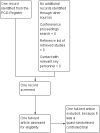Hypnosis for induction of labour
- PMID: 25118632
- PMCID: PMC10749447
- DOI: 10.1002/14651858.CD010852.pub2
Hypnosis for induction of labour
Abstract
Background: Induction of labour using pharmacological and mechanical methods can increase complications. Complementary and alternative medicine methods including hypnosis may have the potential to provide a safe alternative option for the induction of labour. However, the effectiveness of hypnosis for inducing labour has not yet been fully evaluated.
Objectives: To assess the effect of hypnosis for induction of labour compared with no intervention or any other interventions.
Search methods: We searched the Cochrane Pregnancy and Childbirth Group's Trials Register (31 January 2014), handsearched relevant conference proceedings, contacted key personnel and organisations in the field for published and unpublished references.
Selection criteria: All published and unpublished randomised controlled trials (RCTs) and cluster-RCTs of acceptable quality comparing hypnosis with no intervention or any other interventions, in which the primary outcome is to assess whether labour was induced.
Data collection and analysis: Two review authors assessed the one trial report that was identified (but was subsequently excluded).
Main results: No RCTs or cluster-RCTs were identified from the search strategy.
Authors' conclusions: There was no evidence available from RCTs to assess the effect of hypnosis for induction of labour. Evidence from RCTs is required to evaluate the effectiveness and safety of this intervention for labour induction. As hypnosis may delay standard care (in case standard care is withheld during hypnosis), its use in induction of labour should be considered on a case-by-case basis.Future RCTs are required to examine the effectiveness and safety of hypnotic relaxation for induction of labour among pregnant women who have anxiety above a certain level. The length and timing of the intervention, as well as the staff training required, should be taken into consideration. Moreover, the views and experiences of women and staff should also be included in future RCTs.
Conflict of interest statement
None known.
Update of
- doi: 10.1002/14651858.CD010852
References
References to studies excluded from this review
Omer 1987 {published data only}
-
- Omer H, Sirkovitz A. Failure of hypnotic relaxation in the treatment of postterm pregnancies. Psychosomatic Medicine 1987;49(6):606‐9. - PubMed
Additional references
ACOG 2009
-
- ACOG Committee on Practice Bulletins. ACOG Practice Bulletin No. 107: Induction of labor. Obstetrics & Gynecology 2009;114(2 Pt 1):386‐97. - PubMed
Allman 2001
-
- Allman JM, Hakeem A, Erwin JM, Nimchinsky E, Hof P. The anterior cingulate cortex. The evolution of an interface between emotion and cognition. Annals of the New York Academy of Sciences 2001;935:107‐17. - PubMed
Burrows 2001
-
- Burrows GD, Stanley RO. Introduction to clinical hypnosis and the hypnotic phenomena. In: Burrows GD, Stanley RO, Bloom PB editor(s). International Handbook of Clinical Hypnosis. West Sussex, UK: John Wiley & Sons, Ltd, 2001:3‐17.
Cyna 2003
-
- Cyna AM, Andrew MI. Induction of labour using switchbox imagery during hypnosis. Australian Journal of Clinical and Experimental Hypnosis 2003;31(1):74‐87.
Cyna 2004
-
- Cyna AM, McAuliffe GL, Andrew MI. Hypnosis for pain relief in labour and childbirth: a systematic review. British Journal of Anaesthesia 2004;93(4):505‐11. - PubMed
Cyna 2006
Etkin 2011
Faymonville 2000
-
- Faymonville ME, Laureys S, Degueldre C, DelFiore G, Luxen A, Franck G, et al. Neural mechanisms of antinociceptive effects of hypnosis. Anesthesiology 2000;92(5):1257‐67. - PubMed
Fist 1960
-
- Fist HS. Acceleration of labour by hypnotic suggestion: a case report. American Journal of Clinical Hypnosis 1960;3:60‐1.
Green 2005
-
- Green JP, Barabasz AF, Barrett D, Montgomery GH. Forging ahead: the 2003 APA Division 30 definition of hypnosis. International Journal of Clinical and Experimental Hypnosis 2005;53(3):259‐64. - PubMed
Grobman 2007
-
- Grobman WA. Elective induction: When? Ever?. Clinical Obstetrics and Gynecology 2007;50(2):537‐46. - PubMed
Gulmezoglu 2012
Higgins 2011
-
- Higgins JPT, Green S, editors. Cochrane Handbook for Systematic Reviews of Interventions Version 5.1.0 [updated March 2011]. The Cochrane Collaboration, 2011. Available from www.cochrane‐handbook.org.
Humphrey 2009
-
- Humphrey T, Tucker JS. Rising rates of obstetric interventions: exploring the determinants of induction of labour. Journal of Public Health 2009;31(1):88‐94. [PUBMED: 19141563] - PubMed
Jones 2012
Madden 2012
Marazziti 2008
-
- Marazziti D, Catena Dell'osso M. The role of oxytocin in neuropsychiatric disorders. Current Medicinal Chemistry 2008;15(7):698‐704. - PubMed
Montgomery 2000
-
- Montgomery GH, DuHamel KN, Redd WH. A meta‐analysis of hypnotically induced analgesia: how effective is hypnosis?. International Journal of Clinical and Experimental Hypnosis 2000;48(2):138‐53. - PubMed
Mozurkewich 2011
Netherton 2011
-
- Netherton E, Schatte D. Potential for oxytocin use in children and adolescents with mental illness. Human Psychopharmacology 2011;26(4‐5):271‐81. - PubMed
RevMan 2014 [Computer program]
-
- The Nordic Cochrane Centre, The Cochrane Collaboration. Review Manager (RevMan). Version 5.3. Copenhagen: The Nordic Cochrane Centre, The Cochrane Collaboration, 2014.
Rice 1961
-
- Rice FG. Hypnotic induction of labour a series of 6 cases. American Journal of Clinical Hypnosis 1961;4:119‐31.
Scantamburlo 2007
-
- Scantamburlo G, Hansenne M, Fuchs S, Pitchot W, Marechal P, Pequeux C, et al. Plasma oxytocin levels and anxiety in patients with major depression. Psychoneuroendocrinology 2007;32(4):407‐10. - PubMed
Shin 2010
Simkin 2004
-
- Simkin P, Bolding A. Update on nonpharmacologic approaches to relieve labor pain and prevent suffering. Journal of Midwifery and Women's Health 2004;49(6):489‐504. - PubMed
Torem 1992
-
- Torem MS. The use of hypnosis with eating disorders. Psychiatric Medicine 1992;10(4):105‐18. - PubMed
Valente 1990
-
- Valente SM. Clinical hypnosis with school‐age children. Archives of Psychiatric Nursing 1990;4(2):131‐6. - PubMed
Werner 1982
-
- Werner WE, Schauble PG, Knudson MS. An argument for the revival of hypnosis in obstetrics. American Journal of Clinical Hypnosis 1982;24(3):149‐71. - PubMed
Werner 2013
-
- Werner A, Uldbjerg N, Zachariae R, Rosen G, Nohr EA. Self‐hypnosis for coping with labour pain: a randomised controlled trial. BJOG :an international journal of obstetrics and gynaecology 2013;120(3):346‐53. - PubMed
WHO 2011
-
- World Health Organization. WHO recommendations for induction of labour. Geneva: World Health Organization 2011.
Publication types
MeSH terms
LinkOut - more resources
Full Text Sources
Other Literature Sources
Research Materials


